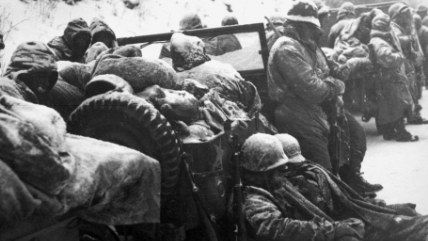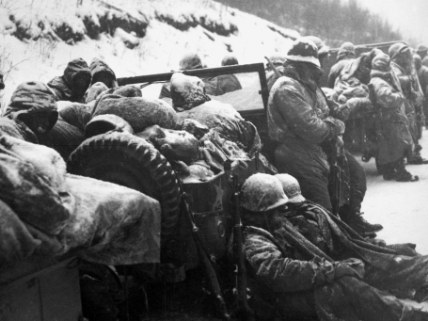Documentary Recalls Horrors of Korean War
Survivors detail brutal Battle of Chosin.


American Experience: The Battle of Chosin. PBS. Tuesday, November 1, 9 p.m.
When the Chinese mortar shell exploded, it sent the American soldier hurtling through the air, his body savaged but his mind eerily dreamy as he fell back to earth, cataloging the carnage surrounding him. He took particular note of a severed limb casually askew on the ground. "Some poor guy lost a leg," the soldier thought to himself sadly. When he tried to stand, the dream blinked back to reality: The poor guy without a leg was him.
So it goes in The Battle of Chosin, an episode of the PBS documentary series American Experience airing November 1. It's a series of postcards—surreal, grisly, terrifying—from a largely forgotten battle in the mostly unremembered war that the United States fought in Korea from 1950 to 1953.
For two weeks beginning in late November 1950, a U.S.-commanded force of nearly 15,000 men, mostly U.S. Marines, fought its way out of an encirclement of 120,000 Chinese troops near the Chosin Reservoir in North Korea. The combat, at such close quarters that the fighting was often hand-to-hand, took place on steep, craggy mountain terrain ("you had two directions to go in Korea, that was either straight up or straight down, recalls one American soldier) in temperatures that plunged to 50 degrees below zero on some nights. It was a frozen killing field so gruesome that the soldiers interviewed in The Battle of Chosin are often reduced to ghastly free association in their attempts to describe it: "Grotesque. … Horrible. Nightmare."
Producer-director Randall MacLowry and writer Mark Zwonitzer, though both American Experience veterans (together and separately, they've chronicled everything from the creation of Silicon Valley to the campaign to stamp out polio), have little experience in making military documentaries.
That doesn't show at all in The Battle of Chosin, which dexterously alternates between broad discussions of strategy and grunt's-eye-view of the fighting on the ground. They've assembled a truly awesome collection of archival footage and still photographs; as grim and exhausting as the battle got, military combat photographers apparently never put down their cameras.
Battle opens with a quick, deft summary of the outbreak of the Korean War five months earlier. North Korean troops poured across the border, quickly captured Seoul and within a few weeks were on the verge of driving out U.S. and South Korean forces. But American commander Douglas MacArthur's risky decision to launch an amphibious assault behind the North Korean lines broke the communist offensive, sending them in headlong retreat north with U.S. forces in hot pursuit.
As Thanksgiving approached, American troops were nearing the Yalu River, the border between North Korea and China, and U.S. forces were so totally in control that American planes were ferrying turkey and dressing rather than bombs and bullets to the front. Though there were some nervous voices in Washington—including that of President Truman himself—expressing worries that China might intervene on behalf of the shattered North Korean army, MacArthur dismissed the Chinese as a "peasant army" that would crumble in the face of American military technology. Even when American troops traded some sporadic shots with infiltrated Chinese soldiers—their distinctive quilted uniforms made them easy to recognize—U.S. commanders were unconcerned.
The spearhead of the drive on the Yalu was the 1st U.S. Marine Division, augmented by smaller units of the U.S. and South Korean army, arrayed in a semi-circle around the Chosin Reservoir on the eve of an offensive that their commanders had promised them would end the war by Christmas. Instead, they were awakened the night of Nov. 27 by a series of murderous human-wave attacks by a Chinese force that would number at least 60,000 soldiers.
Under-armed (only the first wave of men all carried guns; most of those in subsequent waves were expected to snatch their weapons from the carpet of corpses they raced across toward U.S. lines), the Chinese used their massive advantage in sheer numbers to overrun American positions.
"You didn't have to look where they were," recalls one American soldier. "In back of you. In front of you. Right around you, right in the middle of you." Bullets gave way to bayonets and rifles turned into clubs, bodies were strewn everywhere. "It's terrifying," says another soldier. "You know you're gonna die and you wonder how it's gonna happen."
Even after the first night's fighting, U.S. commanders remained sanguine. "You gonna let a few Chinese laundrymen stop you?" U.S. Army General Ned Almond sneered to his officers on the ground. By the second night, American forces were completely surrounded and had no choice to fight their way south, 80 miles down a road built for oxcarts, the Chinese bombarding them from the surrounding peaks every step of the way.
The Battle of Chosin is a melange of horrifying images that compound themselves into something other-worldly. Newsreel shows Marines chipping uselessly at the frozen ground with picks in a futile effort to dig foxholes to shelter themselves from the glacial winds and the clouds of enemy bullets. When that didn't work, survivors explain, they huddled inside walls made of icy Chinese corpses.
American dead, too, were put to work; they were stripped naked so their clothing could be searched for stray ammo or grenades, then wrapped around wounded men, stacked three deep in trucks, in an often futile attempt to keep them from freezing to death. The arctic cold inflicted almost as much damage on the Marines as the Chinese did; the photos of blackened, mutilated feet will forever dispel you of any idea that frostbite is a minor injury. One soldier describes how when medics finally used an axe to get his frozen boots off, his toes stayed inside.
Sometimes words fail the survivors, particularly when they're describing the weapon that saved so many of them: napalm, dropped by American planes on Chinese attackers at altitudes so low that soldiers on the ground could see their faces as they flew by. A Marine who walked through a field of charred Chinese corpses after one of the attacks can say only, "There were smells that, to this day, I can't get rid of." Other times their stories have no narrative point but are merely—though that's surely not the right word—horrifying images trapped in their brains seven decades later, including one of an American soldier's body windmilling down a mountainside, his face torn off by a Chinese shell, blood spraying everywhere in what seems like a terrible rebuke to the very concept of humanity.
If Battle goes off-track anyplace, it's in the documentary's brief forays into political analysis—particularly the undisputed assertion of University of Chicago historian Bruce Cumings, a longtime apologist for North Korea's Stalinst Kim dynasty, that China's decision to send troops into North Korea was an understandable act of self-defense by an innocent bystander to American aggression. "What would the U.S. do if the Chinese communist army were marching up Mexico, talking about rolling back American capitalism in the Southwest?" asks Cumings in wide-eyed innocence. That's a scrambled analogy that not only ignores the fact that North Korea's invasion of the South started the war, but voluminous documentary evidence uncovered by other historians that Mao lobbied Joseph Stalin for more than a year to approve the invasion, promising help from Chinese troops if anything went awry.
But that errant minute or two of Battle is easily ignored in a documentary that is a both a magnificent piece of military history and an appalling testament to the reality of war. The latter includes testimony that the soldiers at the Chosin Reservoir, even in the battle's ugliest moments, retained a heartbreaking ability to recognize their own roles in an agonizing tableau of suffering and bloodshed.
One Marine, after tossing a grenade into an enemy bunker, entered it to find a lone Chinese machine-gunner still at his post, his legs and stomach torn away but his heart somehow still beating. "He kept talking to me in Chinese," the American remembers, his eyes red and moist. "Was he telling me about his family; was he pleading with me to dispatch him? … I still think about him at night sometimes, just wishing I could have understood what he was saying. It's nothing to kill them at a distance. It's when you look them in the eye, that's different." The Battle of Chosin never breaks its gaze.
Show Comments (61)